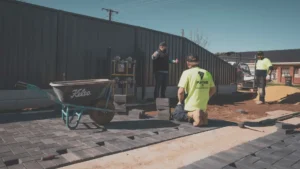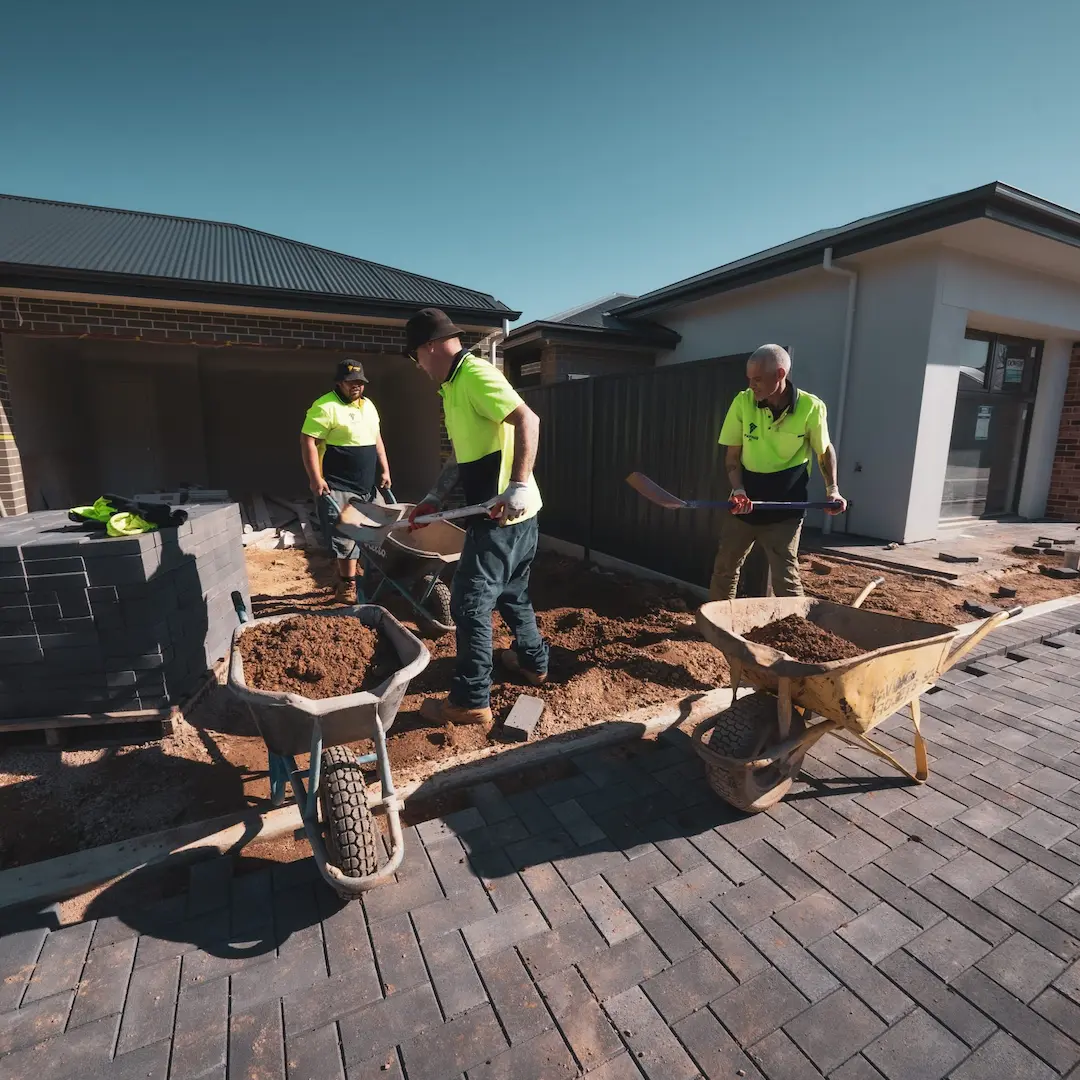Need to cut paving bricks but not sure where to start? This straightforward guide on “how to cut paving bricks” offers everything you need to know about choosing the right tool and executing the cut with precision. From safety tips to avoid common pitfalls to actionable methods for both straight and curved cuts, you’ll discover how to tackle this task with confidence, all while keeping fluff to a minimum. For the best paving Adelaide has to offer, speak to the team at Paving SA for a free quote!
Key Takeaways
- Cutting paving bricks requires specific tools for different needs: a circular saw with a diamond blade for clean cuts, a hammer and chisel for classic cutting, and an angle grinder for intricate cuts and angles.
- Preparation is crucial for precision in cutting paving bricks, involving accurate marking and wearing appropriate safety gear like goggles, gloves, and dust masks to prevent injuries and health risks.
- For maintaining and enhancing paving stones post-cut, it’s recommended to perform regular checks, refill the joints periodically, use quality bedding sand, engage in frequent sweeping, occasional low-pressure washing, and consider sealing the pavers.
Essential Tools for Cutting Paving Bricks
Like a master chef with their signature knives, achieving perfection in cutting paving bricks requires having the right tools at your disposal. Whether it’s a circular saw with a diamond blade, a brick set chisel, or an angle grinder, each tool offers unique benefits for your cutting needs.
We will examine each one in detail.
The Power Duo: Circular Saw and Diamond Blade
A circular saw paired with a diamond masonry blade is like the perfect tag team in a wrestling match – they are powerful and precise. This duo, often referred to as a saw blade, is ideal for efficient and clean cuts on a flat surface. The diamond blade is specially designed for masonry and stone, making it the ideal blade for cutting through tough materials like:
- paving bricks
- concrete blocks
- ceramic tiles
- granite
- marble
When using this power duo, safety is paramount. Here are some important steps to follow:
- Ensure the paving bricks are secured in place using a non-slip mat or clamps, preventing any movement during the cutting process.
- Protect the circular saw base by covering it with blue painter’s tape.
- Make sure the cutting is done on a sturdy board to provide a flat and stable surface.
The Classic Approach: Hammer and Chisel
The hammer and chisel method is the classic, no-fuss approach to cutting paving bricks. This technique, while traditional, is incredibly effective, especially for smaller projects or softer materials. By simply following these steps, you can achieve a clean break on the paving brick:
- Create a sharp edge on the brick using the chisel.
- Position the chisel on the marked line where you want to make the cut.
- Apply force with the hammer to the chisel, gradually increasing the pressure until the brick breaks along the desired line.
However, bear in mind that although this method appears straightforward, it demands a certain finesse. Striking the chisel too hard could lead to chipping off a bit of the paver, affecting the final result.
The final step entails firmly tapping the overhanging end with a hammer or mallet to cleanly break the paver.
Precision Cutting with an Angle Grinder
For those intricate cuts and precise angles, an angle grinder is your best friend. It’s particularly useful when cutting angles or curves into pavers, providing a level of precision that’s hard to achieve with other tools.
When using an angle grinder, follow these steps for a clean cut:
- Make the initial cut between 1/8 inch and 1/4 inch deep.
- Place a chisel in the center of the cut line.
- Strike the chisel firmly with a hammer after the initial angle grinder pass.
This technique not only ensures a clean cut but also helps to preserve the quality of the blade.
Preparing to Cut Paving Bricks
Before you dive into the cutting process, there’s some groundwork to be done. Proper preparation is key to achieving those ideal cuts on your cut pavers. This involves accurately marking your cutting pavers and ensuring you’re geared up with the right safety equipment.
Marking Your Pavers for Accuracy
Marking your pavers is akin to the old adage, “measure twice, cut once.” Accurate marking ensures precise cuts and ultimately results in a professional finish. The tools you’ll need for marking include:
- Chalk line
- Lead concrete marker pen
- Pastel/wax paver markers
- Soapstone pavers marker
- Measuring and marking tool for precise measurement
To guarantee accuracy, marking the cutting line on all faces of the brick is imperative. To mark the top face of the paver, use a pencil and either a square or a straightedge for accuracy. This will ensure precise and clean markings on the surface. Just remember, clear and visible lines are the foundation of a great cut.
Safety First: Gear Up Before You Start
Any DIY project comes with safety considerations, and cutting paving bricks is no exception. In fact, it’s necessary to wear safety goggles and hearing protection when handling these tools.
When using a power saw to cut paving bricks, it’s recommended to wear additional safety gear such as:
- Goggles to protect your eyes
- Gloves to guard your hands
- Ear protection to preserve your hearing
- A respirator or dust mask to help prevent inhaling harmful silica dust
Each piece of safety gear serves a unique purpose.
Don’t forget, your safety is of utmost importance.
The Step-by-Step Guide to Cutting Paving Bricks
Now that you’re outfitted with the appropriate tools and safety gear, it’s time to get down to business. Here’s a step-by-step guide to help you master the art of cutting paving bricks, from scoring the initial groove to smoothing out rough edges.
Scoring for Success: Creating the Initial Groove
The first step in the cutting process is to create a groove or “score” on the paver. This is achieved by:
- Placing the paver flat on a sturdy surface
- Positioning the chisel edge into the groove at the center of the paver’s face
- Giving a sharp tap with the hammer to create the initial score line.
Scoring the paver not only establishes a guide for the final cut, but it also mitigates the risk of breakage. It’s recommended to create a groove approximately 1/16-inch deep to serve as an effective guide without risking breakage. This simple technique sets the stage for a clean, precise cut.
Making the Cut: Using Your Tools Effectively
After scoring your paver, it’s time to make the cut. This can be achieved with a variety of tools, depending on your needs and the complexity of the project. Some options for cutting concrete pavers include:
- A wet saw fitted with water lubrication and dust suppressor can make a clean cut all the way through the paver.
- A chisel and hammer can be used for smaller, more precise cuts.
- A circular saw with a masonry blade can also be used for straight cuts.
Choose the tool that best suits your needs and follow the appropriate safety precautions when making your cuts.
If you’re using a hammer and chisel, follow these steps to split and trim a brick:
- Hit the end of the chisel with the hammer to split the brick.
- If the brick does not split, score it with a cold chisel, then try splitting again.
- For trimming and smoothing imperfections, use the chisel to chip off protrusions.
The Finishing Touch: Smoothing Rough Edges
A major part of achieving a polished finish lies in smoothing out rough edges after the cut. This can be done using:
- Screeds
- Straight edges
- Diamond concrete grinding discs
- Hand sanding with a 20 grit concrete rub brick
- Diamond cutting disc
These methods are effective for creating a polished finish.
Keep in mind, safety is also critical during this process. Always wear eye protection and safety glasses to avoid injuries from sharp edges. Taking care to prevent chipping during the smoothing process is also crucial. For this, setting up a debris catcher and using a 20 grit concrete rub brick for hand sanding is recommended.
Alternative Methods for Specific Situations
While the methods we’ve discussed so far are broadly applicable, there are times when you might need to use alternative techniques. These might include using a wet saw for dust reduction and precision, or a brick splitter for quiet cutting.
We’ll examine each in more detail.
Wet Saws: Keeping Dust Down and Precision Up
A wet saw offers numerous advantages during the cutting process. For one, it reduces dust by suppressing airborne particles with water flow, ensuring precise cuts. The water also cools the blade, preventing overheating and resulting in smoother, more controlled cuts.
When using a wet saw to cut wet tile, it’s important to ensure that water is flowing over the blade before turning on the saw. The paver should be carefully slid into the blade without applying excessive force. This method ensures a clean, dust-free cut while minimising the risk of damage to the paver.
The Quiet Cutter: Using a Brick Splitter
If you’re looking for a quieter alternative to power tools, consider using a brick splitter. A brick splitter functions similarly to a log splitter, cleanly splitting paving bricks along a predetermined line.
The process of using a brick splitter involves:
- Marking a line and cutting a 1/16 inch groove on all sides of the paver.
- Placing the paver in the guillotine with the score line parallel to the blade.
- Applying pressure to the handle to split the brick.
The result is a combination of concrete pavers and stone pavers, both with near-perfectly straight edges, providing a clean and professional finish.
Custom Cuts: Handling Curves and Complex Shapes
So far, we’ve covered straight cuts, but what about curves and complex shapes? For those who want to add a little flair to their paving projects, we’ve got some tips and techniques to help you handle those custom cuts.
Navigating Curves with an Angle Grinder
While creating curves in your paving bricks might seem intimidating, it’s actually simpler than you’d expect with an angle grinder. A standard size angle grinder, such as a 4.5-inch model, is ideal for this purpose, and a diamond blade is crucial for the best results.
To maintain control and smoothness during curved cuts, it’s important to keep the blade cool. This can be achieved by using a wet saw or by spraying water on the blade if you’re using a dry saw. By following these tips, you can navigate curves with ease and precision.
Creative Cuts: Combining Tools for Unique Shapes
For those who want to push the envelope with their paving projects, combining tools can help you achieve unique and creative cuts. By using an angle grinder for precision and a hammer and chisel for handcrafted shapes, you can create distinctive designs in your paving bricks.
Thorough preparation is vital for creative cuts. Here are some steps to follow:
- Learn various paving patterns.
- Organise your tools and materials.
- Perform a dry run to foresee potential issues. By following these steps, you can ensure a smooth execution of your project. Remember, the key to a unique project lies in your creativity and your understanding of how to use your tools effectively.
DIY Versus Professional Assistance
The decision to cut paving bricks yourself or hire a professional often boils down to your comfort level, your budget, and the complexity of your project. While DIY cutting can be cost-effective, it requires a certain level of expertise and understanding of the process.
On the other hand, hiring a professional service can ensure a high-quality outcome, especially for larger or more complex projects. However, this comes at a higher cost compared to DIY. Ultimately, the decision depends on your specific needs and circumstances.
Maintaining Your Paving Stones Post-Cut
Once you’ve successfully cut and laid your paving bricks, maintaining them is essential to ensure they last long and retain their polished look. Regular checks, refilling the joints every six months, and using a good quality washed bedding sand under the pavers are key steps to maintaining your paving stones.
Furthermore, general upkeep such as frequent sweeping, occasional low-pressure washing, and sealing the pavers can protect them from elements and stains. For deeper cleaning, power washing can be done. Just remember, regular maintenance can prolong the life and enhance the beauty of your paving bricks.
Summary
Cutting paving bricks like a pro requires the right tools, a good understanding of the process, and attention to detail. From selecting the right tools like the circular saw with a diamond blade, the hammer and chisel, or the angle grinder, to preparing the pavers accurately and ensuring your safety, every step is integral to achieving that flawless cut.
Whether it’s a straight cut, a curve, or a complex shape, the key lies in understanding the technique and applying it with precision. And remember, while DIY can be a rewarding experience, don’t hesitate to seek professional assistance if the project requires it. With these tricks up your sleeve, you’re now ready to take your paving projects to the next level.
Frequently Asked Questions
How do you cut bricks and pavers?
You can use a wet saw, brick/paver splitter, or a hammer and cold chisel for cutting bricks and pavers. Circular saws, angle grinders, and concrete saws are also effective cutting tools, with some featuring built-in water hoses for wet-cutting.
What tool is used to cut paving?
You can use tools such as a hand-held masonry saw, circular saw, angle grinder, or splitter to cut concrete pavers. Each tool has its own advantages depending on the specific project.
How do I prepare to cut paving bricks?
To prepare for cutting paving bricks, make sure to accurately mark the pavers and wear the necessary safety gear for the task.
Are there alternative methods for specific situations?
Yes, alternative methods for specific situations include using a wet saw for dust reduction and precision, or a brick splitter for quiet cutting. Both options offer specialised benefits for different needs.
How do I maintain my paving stones after cutting?
To maintain your paving stones after cutting, regularly check them, refill the joints every six months, and use a good quality washed bedding sand underneath the pavers. This will help ensure their longevity and stability.




